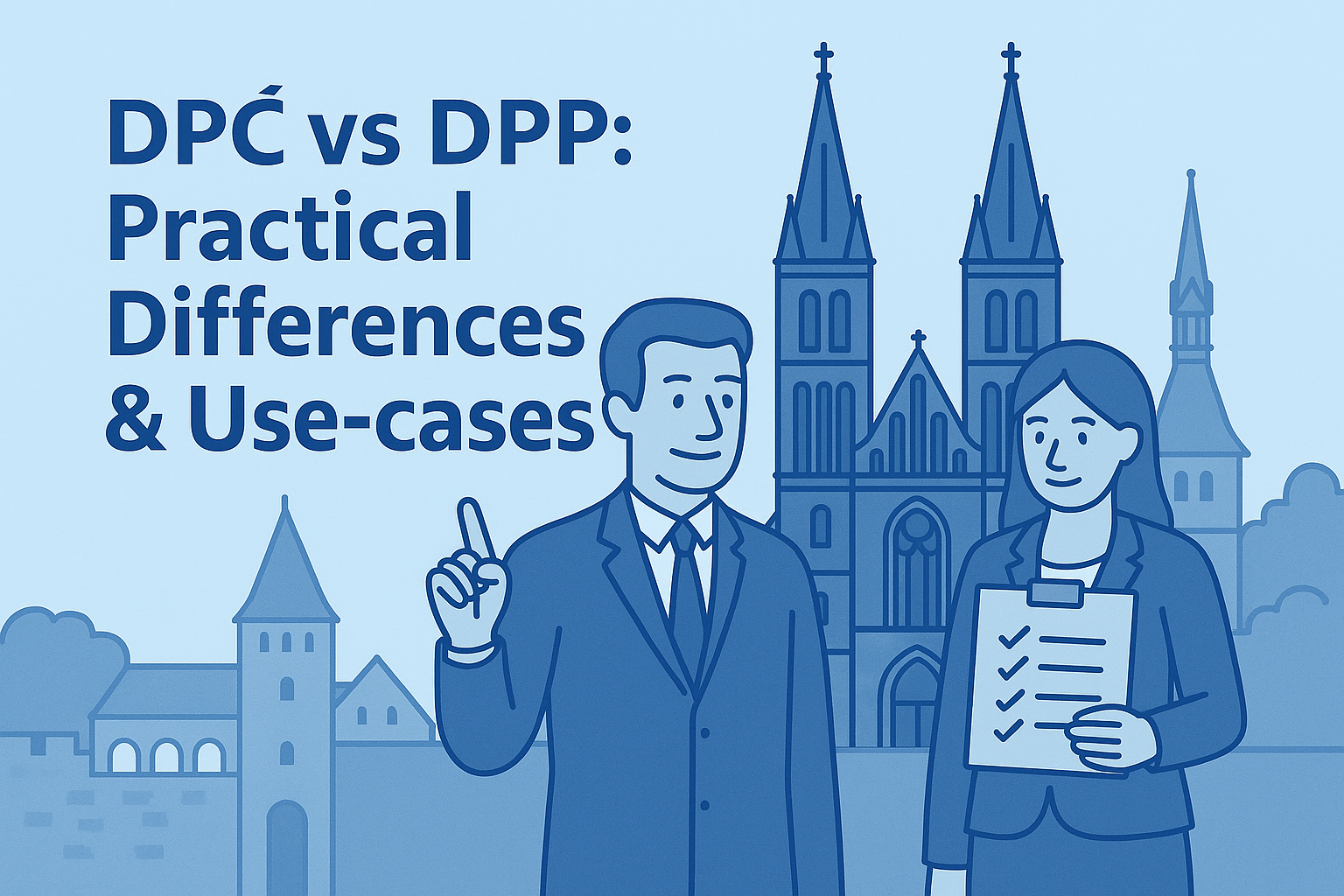DPC vs DPP Czech Republic remains one of the most frequent decisions for HR, finance, and expats. Both are flexible agreements, yet they differ in how you plan working time, when insurance applies, how tax is calculated each month, and what documents you must keep for audits. Use this guide to compare rules side-by-side and pick the right setup for each role.
In this guide
1) DPC vs DPP Czech Republic — definitions 2) Limits & insurance thresholds 3) Tax & monthly logic 4) Real-world scenarios 5) Practical compliance tips 6) Common mistakes FAQBook a 30-min Payroll Q&A
Have a DPC vs DPP Czech Republic question? Get a quick, practical answer tailored to your case.
1) DPC vs DPP Czech Republic — definitions
DPC / DPČ (Dohoda o pracovní činnosti) — ongoing part-time style agreement with an average weekly hours cap. Better for predictable workloads where social and health insurance typically apply and the relationship resembles regular part-time employment.
DPP (Dohoda o provedení práce) — short, ad-hoc agreement with a strict annual hours cap. Ideal for occasional tasks and small projects when monthly income stays below the insurance threshold and the collaboration is not a steady part-time role.
2) Limits & insurance thresholds
| Criterion | DPC (DPČ) | DPP |
|---|---|---|
| Working time cap | Average up to 20 hours/week | Max. 300 hours/year per employer |
| Insurance threshold | CZK 4,500/month → insurance applies; below: no insurance | CZK 11,500/month → insurance applies; below: no insurance |
| Tax | Usually advance tax; credits apply with declaration | Depends on signed taxpayer declaration; under threshold may be withholding; above or with declaration → advance tax |
| Admin load | Higher — track average weekly hours, insurance, and documentation | Lighter — track 300h/year + monthly threshold |
| Typical use-cases | Regular part-time roles, students, return-to-work | One-off tasks, events, seasonal spikes |
When comparing DPC vs DPP Czech Republic, always test thresholds per month and per employer. If several DPP contracts exist with the same employer, their income can be aggregated for the monthly threshold test.
3) Tax & monthly logic
- Taxpayer declaration (signed with one employer) unlocks personal credits/bonuses and affects whether withholding or advance tax is used.
- Rate bands: 15% / 23% based on the monthly tax base (watch changes for the relevant year).
- Insurance applies when monthly income meets the threshold: DPC from CZK 4,500; DPP from CZK 11,500.
- Evidence for DPC: keep a work schedule (or timesheets) to support the 20h/week average cap; adjust terms if the pattern changes.
4) Real-world scenarios
Student helper (12–16h/week)
The role is predictable and continues through the semester with monthly income around or above CZK 4,500. DPC is more appropriate: insurance applies, and a basic schedule supports the 20h/week average requirement.
Occasional specialist
A marketing contractor supports two sprints in spring and one in autumn. Each month stays under CZK 11,500 and the total hours remain below 300 per employer. DPP fits, provided you track hours centrally and watch the monthly threshold.
Seasonal peaks
Most months are low, but two months exceed the thresholds. Use DPP for genuinely occasional months and DPC (or even HPP) if the collaboration becomes a stable pattern. Avoid using DPP to mask ongoing part-time work.
5) Practical compliance tips
- Track DPP hours: 300h/year per employer is strict — audit monthly and stop assigning DPP tasks once reached.
- Aggregate DPP income: Multiple DPPs in the same month with one employer may together cross CZK 11,500 and trigger insurance.
- Keep documents: taxpayer declaration, DPC schedule, consents, amendments, and any addenda that change working patterns.
- Monitor thresholds: DPC 4,500 / DPP 11,500; update the agreement when income patterns change (e.g., moving from occasional to regular work).
- Payslip clarity: show statutory net vs post-net (take-home) separately to avoid confusion.
See how this appears on Czech payslips
6) Common mistakes
- Using DPP for stable part-time work: repeating patterns indicate DPC or HPP is safer.
- Ignoring aggregation: several DPPs in one month with the same employer can cross CZK 11,500.
- No DPC schedule: without evidence, the 20h/week average cap is hard to defend in audits.
- Confusing net with take-home: statutory net ≠ bank transfer after personal deductions/reimbursements.
If unsure, step through the triangle: pattern (occasional vs regular), threshold (4,500/11,500), and evidence (hours, schedule, documents). That resolves most DPC vs DPP Czech Republic cases consistently.
FAQ
Disclaimer: Informational only. Verify current thresholds and rules for the relevant year/month.
